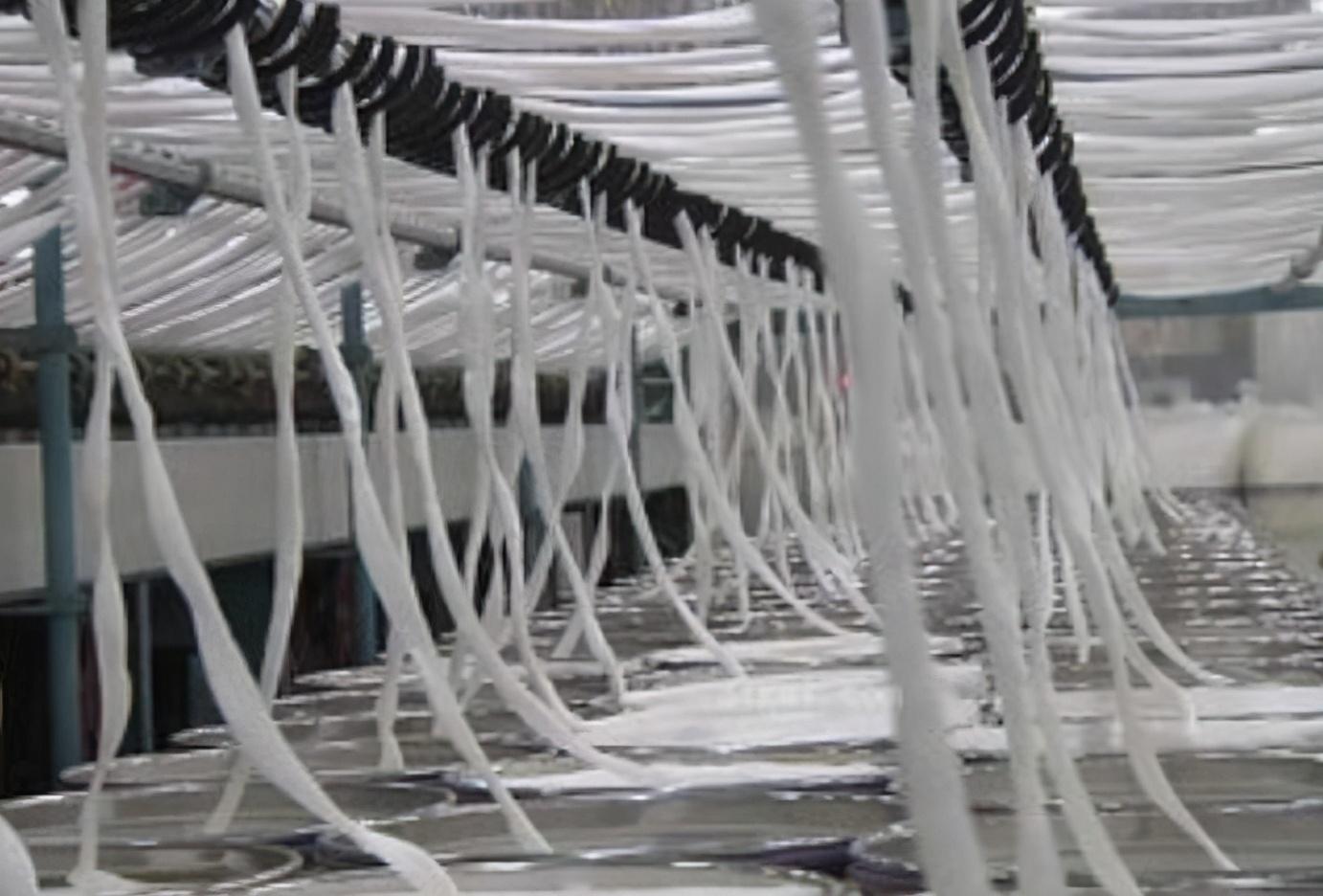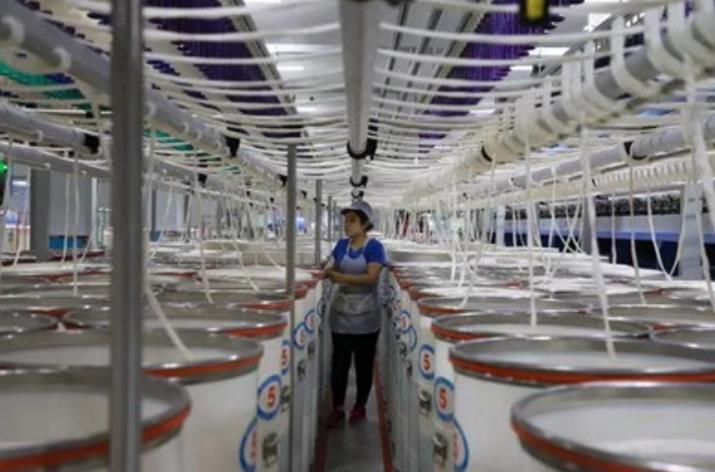Ring spinning
This is the most commonly used and most common spinning method on the market. The fiber strips after drafting the sliver or roving pass through the ring steel wire The ring rotation is introduced, the bobbin winding speed is faster than the wire ring, and the cotton yarn is twisted into a spun yarn, which is widely used in various short fiber spinning projects. Such as carded, combed and blended, the wire ring passes through the yarn from the bobbin The strip rotates around the steel ring for twisting. At the same time, the friction of the steel ring causes the rotation speed to be slightly smaller than the bobbin and is wound. In the shape of ring-spun yarn, most of the fibers are in the form of a conical spiral that transfers inward and outward, so that the fibers are in the yarn. The inner and outer windings are connected, the yarn has a tight structure and high strength, and is suitable for thread making, weaving and knitting and other products.
Siro spinning
Feed two rovings with a certain distance apart on the spinning frame. After drafting, they are output from the front roller. These two single yarn slivers have a small amount of twist due to the transfer of twist. After being spliced together, they are further twisted into a ply-like yarn and wound on the bobbin. It is characterized by less hairiness, high strength and good wear resistance. The raw material grade used in siro spinning can be lower than that of conventional ring-spun yarn fabrics, and its fabrics have less hairiness than conventional ring-spun yarn fabrics, are soft to the touch, wear-resistant, and have good breathability.

Compact spinning
Spinning on a new and improved ring spinning machine A new type of spinning technology, its spinning mechanism is mainly as follows: a fiber cohesion area is added in front of the traction device of the ring spinning machine, which basically eliminates the spinning twisting triangle area between the front roller and the twisting point. After the fiber slivers are output from the front opening of the front roller, they first pass through the mesh apron coated by the special-shaped suction duct. The slivers move on the mesh apron. Due to the contraction and polymerization of the air flow, the slivers are gathered through the suction groove of the special-shaped tube. It rotates and gradually changes from a flat ribbon to a cylinder. The ends of the fibers are all twisted into the yarn, so the yarn is very tight and the yarn has a smooth appearance and less hairiness. Compactly spun yarns have higher strength and less hairiness, and are least prone to fraying during subsequent processing.
Vortex spinning
Using a licker-in roller to comb into single fibers, and then transport them into the vortex tube, forming a rotating free end yarn under the action of the vortex field The tail ring rotates around the center of the vortex tube and is twisted into yarn. The single fiber fed into the vortex tube enters from the feed inlet, hits the spinning head and bends, then slides down the spinning head and contacts the yarn tail ring to be grabbed, and is randomly added to the yarn tail ring. Due to the transfer of fibers, Straightening, condensation and twisting into yarn are all completed by the suction and rotation of the air flow, so the fiber parallelism and orientation in the yarn are poor, there are many looped fibers, and the surface layer fibers are in a wrapped state, forming a closed loop hairiness. . The yarn structure is relatively bulky, so its dyeability, pulp absorption, and air permeability are relatively good, and the yarn’s pilling resistance and abrasion resistance are also relatively good. The range of yarn count is limited to medium and low count yarns, suitable for fleece products.

Centrifugal spinning
Twisting is implemented with high-speed centrifugal tank (cup) and lifting yarn guide tube Winding continuous spinning method. Roving by drafting
After the device, the front roller continuously outputs fiber strips, and enters the high-speed rotating cylindrical centrifugal tank through the yarn guide hook and yarn guide tube. Under the action of centrifugal force, the yarn sticks to the inner wall of the tank and rotates with the tank, causing the lower end of the yarn guide tube to with front roller
The yarn is twisted, and the horizontal rotation speed of the yarn under the yarn guide tube lags behind the centrifugal tank to produce winding. The yarn guide tube rises and falls according to a certain pattern to form a cross-wound yarn cake. When the winding reaches a certain length requirement , Qianluo
Pull to stop the fiber strip output, the yarn guide tube rises and exits the centrifuge tank, and the empty bobbin is quickly dropped into the centrifuge tank. The yarn end hooks the yarn hook at the bottom of the bobbin, so that the yarn on the yarn cake is unwound to the bobbin. After unwinding, remove the full tube. Same ring
Compared with spindle spinning, the power consumption is high, there is a lot of yarn waste, and it is difficult to deal with end breakage. The yarn is rewound to the bobbin, and the front roller needs to stop, which affects productivity. Currently, few people use it.
Twistless spinning
A spinning method that uses an adhesive to bond the fibers in the fiber strips to each other into yarn. After the roving is drafted by the drafting device, the sliver is sent to the twisting drum, and the thin layer of adhesive from the tank on the return drum is contacted. The fiber sliver is composed of several
The rotating small pressure rollers are transported forward together with the rollers. One of the small pressure rollers also makes axial reciprocating motion at the same time, twisting the fiber strips into a circular cross-section and allowing each fiber to evenly contact the adhesive. Round fiber strips are heated
After drying, the fibers stick to each other and form yarn. The spinning speed can be 2 to 4 times greater than the conventional spinning method, and the yarn produced can be used for weaving.

Self-twist spinning
A non-traditional spinning method. The two fiber strips are stretched through the drafting device, output by the front roller and the twisting roller, and meet at the yarn guide hook. The twisting roller In addition to rotation, it also performs rapid axial reciprocating motion to twist the yarn sliver, so that the yarn sliver before and after the twisting roller is
The two yarn strips are twisted in opposite directions. The two yarn strips combined at the yarn guide hook rely on their own torsional torque to form a double-stranded self-twisting yarn (ST yarn), which is wound into a bobbin. Self-twisting yarn The morphological characteristic is that adjacent yarn segments alternately
There are twists in the forward and reverse directions, and the alternation is untwisted. Add one direction of twist on the twisting machine to make a twisted self-twisted yarn (STT yarn). The two sets of self-twisted yarns have a phase difference of 90° in the untwisted area. The four-ply yarn is configured and combined, simply
It is called “2ST yarn”, and then it is low-twisted on the twisting machine and made into (2ST)T yarn. The two self-combinations are called “(ST)2” yarn. A filament is used to replace a single yarn strip in the self-twisting When, STM and
(STM) T yarn. This spinning method is specially used for multi-strand yarns, such as wool spinning or wool-like chemical fiber products. High-quality self-twisted yarn can be directly used for weft knitting, but the warp yarn for weaving must use twisted self-twisted yarn. Twist the thread to improve strong performance.







